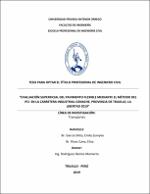Mostrar el registro sencillo del ítem
Evaluación superficial del pavimento flexible mediante el método del PCI en la carretera industrial conache, provincia de Trujillo, la libertad 2019
| dc.contributor.advisor | Rodríguez Ramos, Mamerto | |
| dc.contributor.author | García Shito, Emily Zumyko | |
| dc.contributor.author | Rivas Cano, Elisa | |
| dc.creator | García Shito, Emily Zumyko | |
| dc.date.accessioned | 2019-11-20T21:36:41Z | |
| dc.date.available | 2019-11-20T21:36:41Z | |
| dc.date.issued | 2019 | |
| dc.identifier.uri | https://hdl.handle.net/20.500.12759/5652 | |
| dc.description.abstract | El presente trabajo tiene como objetivo aplicar el método PCI para determinar el Índice de Condición de Pavimento en LA CARRETERA INDUSTRIAL CONACHE. Tres mil metros lineales de pista han sido estudiados a detalle para identificar las fallas existentes y cuantificar el estado de la vía. La tesis presenta marco teórico, donde se define el concepto de pavimento, su clasificación y se explica la problemática que se vive en Trujillo. Así mismo trata de las fallas más comunes que afectan a los pavimentos urbanos flexibles. Se explica el procedimiento del método: el muestreo de unidades, el cálculo del PCI, los criterios de inspección, etc. Se describe la zona de estudio y se detalla el procedimiento de inspección realizado. Finalmente se presentan las hojas de registro, con el respectivo cálculo del índice de condición de pavimento para cada unidad de muestra analizada. Se concluye que LA CARRETERA INDUSTRIAL CONACHE tiene un pavimento de estado malo, con un PCI ponderado igual a 34.53. Finalmente, se han recomendado algunas técnicas de reparación, de acuerdo a las fallas detectadas, para restituir la carretera a su estado original. | es_PE |
| dc.description.abstract | The present work aims to apply the method PCI to determine the Pavement Condition Index in THE CONACHE INDUSTRIAL ROAD. Three thousand linear meters of track have been studied in detail to identify existing faults and quantify the state of the track. The thesis presents theoretical framework, where the concept of pavement is defined, its classification and the problem that is lived in Trujillo is explained. It also deals with the most common faults that affect flexible urban pavements. The procedure of the method is explained: the sampling of units, the calculation of the PCI, the inspection criteria, etc. The study area is described and the inspection procedure is detailed. Finally, the registration sheets are presented, with the corresponding calculation of the pavement condition index for each unit of sample analyzed. It is concluded that THE CONACHE INDUSTRIAL ROAD has a bad state pavement, with a weighted PCI equal to 34.53. Finally, some repair techniques have been recommended, according to the failures detected, to restore the road to its original state | en_US |
| dc.description.uri | Tesis | es_PE |
| dc.format | application/pdf | es_PE |
| dc.language.iso | spa | es_PE |
| dc.publisher | Universidad Privada Antenor Orrego - UPAO | es_PE |
| dc.relation.ispartofseries | T_ING.CIVIL_1801 | |
| dc.rights | info:eu-repo/semantics/openAccess | es_PE |
| dc.source | Universidad Privada Antenor Orrego | es_PE |
| dc.source | Repositorio institucional - UPAO | es_PE |
| dc.subject | Método PCI | es_PE |
| dc.subject | Índice de condición de pavimento | es_PE |
| dc.subject | Pavimento flexible | es_PE |
| dc.title | Evaluación superficial del pavimento flexible mediante el método del PCI en la carretera industrial conache, provincia de Trujillo, la libertad 2019 | es_PE |
| dc.type | info:eu-repo/semantics/bachelorThesis | es_PE |
| thesis.degree.level | Título Profesional | es_PE |
| thesis.degree.grantor | Universidad Privada Antenor Orrego. Facultad de Ingeniería | es_PE |
| thesis.degree.name | Ingeniero Civil | es_PE |
| thesis.degree.discipline | Ingeniería Civil | es_PE |
Ficheros en el ítem
Este ítem aparece en la(s) siguiente(s) colección(es)
-
Ingeniería Civil [1085]

